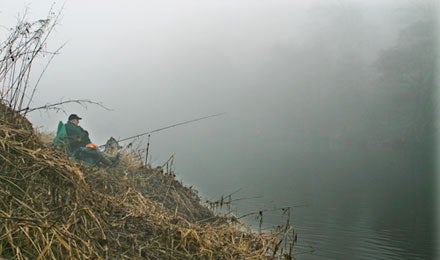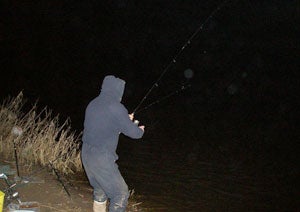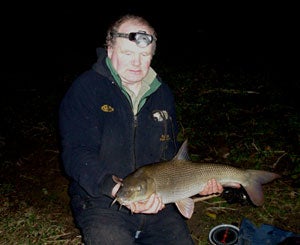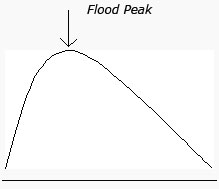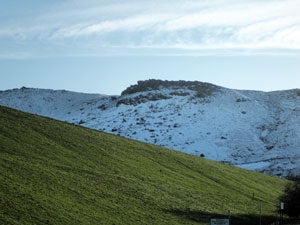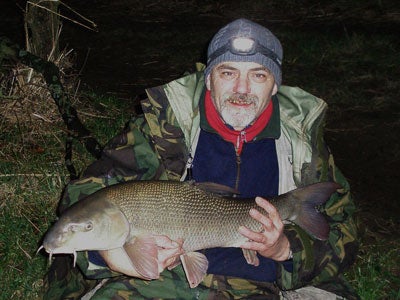Understanding Winter FloodsIt’s often said we should work with nature rather than try to tame it by working against it. I, like most I suspect, who fish rivers during the winter, have attempted to tame it when it’s a swirling, boiling maelstrom of brown and filthy high water.To do this we take outsized leads or feeders with the weight of half a house brick to hold bottom out in the current, but even these get moved at times. The telltale signs are then seen on the rod top as it nods several times until the weight comes to rest, usually nearer to the bank you’re fishing from. In coming to rest, the weight has been pulled into slacker water where the current flow is less. The current reduction in most cases is created by some sort of obstacle, which deflects the flow in another direction – up, or side-to-side. Such obstacles have the potential to be a snag, a snag that you perhaps have never encounter if you’ve only fished the swim in more sedate conditions.
When you fish regularly in such conditions, experience tells you to take a good supply of spare Leads/feeders with you, because you know you’re going to lose some, so you take 6-10 spares with you. Extra Weight What I think we don’t calculate into our exuberance to get out fishing in these conditions, is the extra weight we have to carry. Generally with a metre on, I’d take ten 6oz feeders. That’s 3lb 12 oz of extra weight; not a lot you may think? Add that to the 30 + lb of gear I carry, and a walk of anything up to a mile and a half down the riverbank, through what under these conditions can only be described as a treacle morose of mud. In total all this weight amounts to a heavy load by the time you get to the chosen swim. And they say fishing isn’t physically demanding! On arriving at your chosen swim and if you’ve timed it right with the flood peak, it should be just starting to drop. I’m a firm believer in fishing when the time is right during winter flood conditions.
To get the timing right you need to know how the river reacts to rain in the headwaters and whole catchment area. I gave an example in the last article when I wrote about ‘Reading River Conditions in Autumn’. There are two other methods, which you can use to aid you to get it right, those being: using the EA Rivercall phone service (Note: the EA charge 60p minute for this service) and Internet weather forecast services. Using Rivercall to predict the river levels The EA now have Rivercall on all the main river catchments systems in England and Wales. When you phone up the area Rivercall Number and you have selected the river you wish to fish, you will get height readings from three or more recording sites on the river. The first is always in the headwaters, then mid section, and finally the lower reaches. The heights are put on around 0300 hours and 1500 hours every day. Let’s say you plan to go fishing at the weekend and you only want to uses Rivercall to plan it. It’s advisable to start checking the day before you wish to go, to get a feel for how the river is reacting to the weather, assuming there is some wet weather forecast. So you therefore call Rivercall the day before your trip and it gives you a report for that day, that the river is 0.3 metres up in the headwaters, but dropping, mid section it’s 0.7 and rising, lower 1.2 and rising. From this, you can deduce the flood pulse is in the mid to lower sections. If no more rain is expected in the general region, and dependant on how long the river is, the flood pulse should be mainly in the lower sections or lower middle section by the time you intend to fish it. Note: long rivers have a longer residency time of water remaining in the river than the shorter rivers. Under this scenario I’d be looking at fishing somewhere in the mid section on the tail end of the pulse. Not worrying too much if the river was a little too high when I got there, as I’d know it would be dropping substantially within a few hours. (See Hydrograph illustration)
Link to a more in-depth understanding of how hydrographs work Metcheck Weather Forecasting Service My personal preference when it comes to gauging the likely conditions that I’ll encounter when fishing a session, is to use a combination of rivercall and an accurate weather forecasting service. To forecast the likely weather, or more precisely rain forecast, I use Metcheck (see ‘Regional Weather’ pod to the left of this page or go direct to www.metcheck.com), which I find reasonably reliable. To use it you need to pick a place in the upper catchment that the site recognises. Here I really can’t stress enough, ‘its what’s likely to come down the river that’s most important to getting it right!’ Heavy rain in the hills and a rising flood pulse coming down the river could ruin your prospects within hours on the short river systems. If, however, the weather has been unsettled for a few days, with rain bands pulsing in from the west or southwest from the Atlantic, Metcheck comes into its own because it gives you forecasts at three hour intervals, the likely rain that will fall on the uplands and headwaters. Whereas Rivercall can only tell you what the river was doing at the time the message was put on the line and that’s every 12 hours. Under this example, let’s say you wish to go for a midweek session from mid afternoon to 2200 hours. You look at Metcheck the night before it tells you that there will be a dry break period of 5-8 hours from 0700 to 1300 hours. The river will be dropping in the upper reaches within an hour or two from when the rain stops falling and that fall will continue to move down the river as the hours go by. How fast and how far depends on the residency time it take the river to run it off. This roughly can be worked out by plotting the river’s rising and falling over a 3 – 4 week period under similar circumstances. To catch the tail end of this pulse, I’d be heading for the upper end of the mid section to capitalise on the inevitable feeding period of the fish that reside there. And as I’m not fussed as to what species of river fish I fish for, be those roach, dace, grayling chub or barbel, I’ll amend my tactics accordingly. As a final comment on this, it’s probably obvious to you now, the more experience you have of using this method of prediction, the better you become at it on your river of choice. Longer Rivers like the Severn, Trent and Thames As the length of those rivers is long, it’s possible to fish on the back of one pulse before the next one arrives. And if you’re really motivated and the periods between the rain are right, on the back of two pulses by moving up the river as the second pulse arrives where you’re fishing in the first instance. To do this, you need to take minimum amounts of tackle, so you can be packed in minutes and on your way up the river, which may mean driving 20 miles or so.
In my younger motivated days, I did this on many occasions on the river Severn, moving from Atcham to the Welshpool area. It’s a lot of hassle I know, but the rewards are there for the taking if you put the effort in. On days when the weather was set to dry up for a few days hence, you can, and I did, as I’ve described above, watched where the flood pulse is/was and fished above it with the river in fine fettle as it fined down, taking good catches of chub and the odd barbel in the bargain. In those days, early 80s, the upper reaches of the Severn didn’t have the numbers of barbel it has now. In closing I’d make two final points 1.From Christmas onwards to the end of the season the rivers carry very little in the way of ‘washing line debris’ and it’s quite possible to fish them with 1.5 metres on with big lead/feeders and catch very big barbel. Chub on the other-hand I’ve found don’t seem to like the dirty water, preferring it as the colour starts to drop out. 2. There is one type of flood that I won’t go on any river on and that’s a melt-water flood. Over the years I’ve fished these against my better judgement, and they kill the rivers stone dead. Hopefully over these two articles, I’ve given you enough armoury and knowledge, which you may not have had, to tackle the rivers when they’re carrying a drop more water than when you would normally fish them. “Get out there this autumn and winter, because you don’t catch fish sat in front of the telly with heating full on!!!!”
|
Welcome!Log into your account










